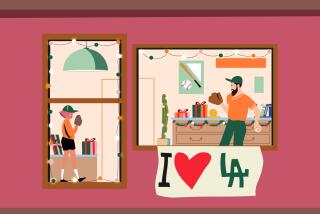ARTISANS : She Takes Her Yarning for Silk to Very Fine Lengths
- Share via
Items for the home that are made of silk are available ready-made in stores, but Connie Childs Elliott of Tustin would rather look to a mulberry tree in her back yard for her silk.
That’s where hundreds of silkworms are chomping away in preparation for spinning cocoons that Elliott will harvest, spin into thread and weave into fabric.
“I love silk for its beauty and strength,” she said. “Yet it’s a time-consuming process to create this fabric that feels so delicate but is actually very strong.”
Elliott, a professional spinner and weaver, says spinning silk isn’t all that different from spinning cotton or wool.
She has been spinning for 17 years and weaving for 10. A geologist by training, Elliott first became interested in this ancient art while she was a college student in Austin, Tex. She spied a group of women spinning under some pecan trees and decided to investigate.
“I didn’t know anything about fibers or crafts,” she said. “But I became so intrigued after watching those women that I decided to learn more.”
After moving with her family to California, she began taking weaving lessons at Denwar Craft Studio in Costa Mesa and now spends several days a week demonstrating both spinning and weaving at Knott’s Berry Farm in Buena Park. She also offers classes on silk spinning and weaving at Piecemakers Country Store in Costa Mesa.
If cotton is the king of fibers, then silk must surely be the queen.
Its beginnings are humble--starting with a worm--yet it ends up as one of the softest and most luxurious of fabrics, prized for centuries by those who appreciated its luster and beauty.
In most cases, silk can be used for the same purposes in the home as cotton or linen--”although I wouldn’t recommend silk dish towels,” Elliott said, smiling. “But silk is a popular fabric because it’s lightweight yet very warm.”
Many people use silk to create afghans or lap robes, she said. “I have a tea cozy that’s made out of silk, and it works beautifully. By using a fluffy silk yarn, I can weave it in a pattern that allows for air pockets that serve as good insulators.
“Because silk drapes beautifully, it is also frequently used for pillow covers or upholstery,” Elliott said. “I’ve seen some beautiful bureau scarves made of silk. Its luster is unmistakable.”
Silk is actually one of the strongest natural fibers, she said. “Its tensile strength is greater than steel.”
It was during a classroom demonstration on spinning and weaving that Elliott first thought of spinning silk.
“The classroom I was visiting had some live silkworms for the children to watch,” she said. “I thought it would be interesting to see if I could use the worms in my lectures. Children, and adults for that matter, often have the chance to see the silkworms go into their cocoons, but they frequently aren’t aware of what happens after that.”
Southern California, with its abundance of mulberry trees, is a silkworm paradise, she said. Since these picky eaters will dine on nothing but mulberry leaves, it is not difficult to find the industrious creatures.
“At the class where I first saw them, the teacher gave me a paper towel that looked like it had little dark circles on it,” Elliott said. “These were silkworm eggs. I put them in an egg carton and kept them in the refrigerator until spring, when the mulberry trees had leaves. I took them out and, before I knew it, I had about 400 silkworms.”
When the worms are young, they are about the size of ants, but they soon grow to be two to three inches long.
“They eat like gangbusters, so every day I was hauling in more mulberry leaves,” Elliott said. “I had them on a tray in my living room. All they’re interested in is eating so you don’t have to worry about them wandering off. After about 30 days, they start spinning their cocoons.”
And it is from the small, soft cocoons that silk is made. However, getting the silk from the tiny cocoon is not easy. “Harvesting” or “reeling” the silk is a painstaking process of slowly unwinding the cocoons that the worms have spun.
“To harvest the silk, you first need to boil or steam the unopened cocoon,” Elliott said. “The sericin or gum that the worm uses to give the cocoon its rigidity must be removed. I simmer the cocoons in a quart of water, a dash of dish detergent and half a teaspoon of washing soda (sodium carbonate).”
Silk can also take on different forms. Raw silk (this differs from the same term used by the fashion industry) refers to silk that still contains sericin. Degummed silk is the smooth-textured fabric that is most commonly used.
*
Once the cocoons have been degummed, they can be carefully pulled apart, and the skin of the pupa is thrown away. What is left is the loose, fluffy fiber that will create the silk.
The technique of spinning silk is the same as for cotton or wool. In its simplest form, spinning consists of twisting the fiber to make it strong.
If creating your own silk sounds like too much trouble but the idea of weaving sounds appealing, there are a number of silk yarns and fibers readily available. Most skeins of silk will cost anywhere from $8 to $15 because the materials are so expensive.
There are also a variety of silk blends where the soft fluffy silk is mixed with other fibers such as camel down, Angora, alpaca, linen and cotton.
“It’s fun to experiment and blending silk is a good way to stretch out those expensive fibers,” Elliott said. “Whenever I spin the silk, I always have a plan in mind so I know how thick the thread should be. You need to have a thread that’s appropriate for the project you have in mind.”
Elliott said she thinks that many enjoy spinning silk because it is a fiber you can create from scratch, and the thread itself is so prized.
Spinning and weaving are also gaining popularity, according to Elliott.
“Spinning is such a relaxing, soothing experience,” she said. “And from that comes an interest in weaving. In the past five years, I’ve seen more people in high-stress occupations, like emergency nurses and teachers, turn to weaving and spinning as a soothing outlet.
“And if you create something you can utilize and enjoy, that’s another benefit.”
Further information on spinning or weaving is available through the South Coast Weavers’ Guild, a nonprofit group devoted to teaching the weaving arts. The following businesses also offer classes in weaving and/or spinning: Denwar Craft Studios in Costa Mesa ((714) 548-1342), Casa de las Tejedoras (House of the Weavers) in Santa Ana ((714) 541-0711), Hares to Ewe in Orange ((714) 771-1807), the Flintlock in Anaheim ((714) 821-6655) and Piecemakers Country Store in Costa Mesa ((714) 641-3112).






